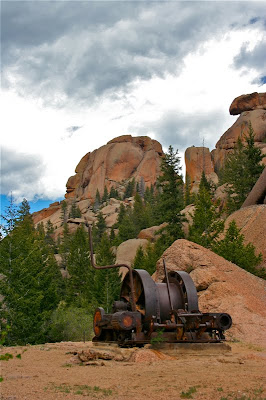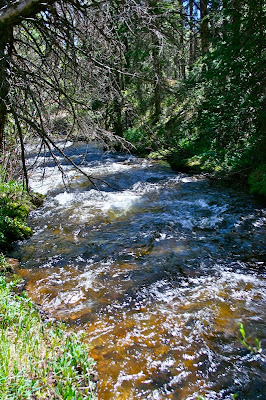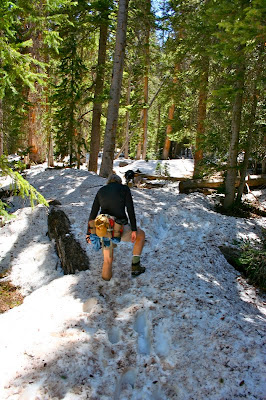Distance: 11 miles round trip
Elevation: 8,247 ft - 8,708 ft
Elevation Gain: 500 ft net (1,876 ft cumulative)
Date Hike: 5 June, 2010
Dogs: Leash only, wilderness area
 Looking north into the Lost Creek Wilderness from our turn around point
Looking north into the Lost Creek Wilderness from our turn around point
Goose Creek Trail in the Lost Creek Wilderness is a journey into an alternate universe of pink, taffy-twisted granite formed into giant domes or pinnacles of inhumanly large Legos. A few miles up the trail and you will wonder where you are. Had the rock been gray instead of pink, I would have thought I was in the Sierra Nevada Mountains. I am so used to Colorado's jagged peaks that I forget just how geologically diverse Colorado really is. I have to remind myself that the eastern plains contain sandstone towers like the
Pawnee Buttes as well as deep canyons like
Vogel Canyon. The broad area near Lost Creek is another such geological wonder. The rock is called pink Pikes Peak Granite and the principal process carving the rocks is weathering and erosion.
 The start of the trail. You can see the burnt trees
The start of the trail. You can see the burnt trees
 Crossing Goose Creek
Crossing Goose Creek
 A typical trail segment
A typical trail segment
The route to the trailhead is long and arduous if coming from the Denver area. It is complex enough that I have included detailed instructions at the end of this post. Much of the drive is through the Hayman burn area which is both fascinating and tragic at the same time. Like the scenery on the nearby
Gashouse Gulch Trail and the
Pine Valley Loop, the skeletons of burnt trees stand as foreboding sentinels to man's seemingly inability to preserve the natural world.
 Rock formations viewed from the trail
Rock formations viewed from the trail

Goose Creek is a haven for backpackers of which we saw plenty. In fact, there were so many cars in the parking lot that we had to park on the road. Since we only ran into 2 other day hiking groups, the rest must have belonged to backpackers who had mostly likely slunk in Friday night and absconded with all the parking.
The trail itself is mostly a wide dirt path filled with gravel. It weaves up and down in a continuous wave, which became really fatiguing on the return trip. I measured the cumulative elevation gain on my GPS and came up with 1,876 ft roundtrip. Some other estimates online were very similar. By the time I returned to the car, I could believe it.
At times the trail meanders through a Ponderosa Pine and Douglas Fir Forest and at other times is perched on a hillside with stunning views of the various rock formations. It can be snowy in the winter and very hot in the summer. We had originally planned on doing this hike 3 weeks ago, but had to cancel due to our May snow dumper. It was around 80° on this trip and the granite rock reflected the sunlight back and forth across the canyon. After our prolonged winter, the heat was most welcome.
 Our first overlook at 2.8 miles. Taken from atop a large dome. There is a tree and some branches that make getting up the dome easy.
Our first overlook at 2.8 miles. Taken from atop a large dome. There is a tree and some branches that make getting up the dome easy.
 Kate and Michael at our lunch spot looking south down the valley. To the right out of from are huge gum-ball boulders with shade.
Kate and Michael at our lunch spot looking south down the valley. To the right out of from are huge gum-ball boulders with shade.
Here are some mileage milestones of our journey: 2.84 miles turn off to a large rock (easy scramble) for incredible views of the Harmonic Arch Area, 4.33 miles turn off to the Shaft House and some historical buildings, 4.71 miles continue from the building towards Shaft House to a super-sized promontory where we ate lunch, 5.36 miles to the Shaft House, and 5.66 miles to a large pile of rocks (here that is like saying "to a tree" in a forest of trees) where we scrambled to our final view of the area.
 One of the old cabins that housed the workmen trying to dam Lost Creek
One of the old cabins that housed the workmen trying to dam Lost Creek
The Shaft House is the remains of a large engineering project that tried to dam Lost Creek. Fortunately for us, this effort failed or this unique and irreplaceable geological and biological area would have been under water.
 An unusual formation on the way to the Shaft House
An unusual formation on the way to the Shaft House
Just beyond the Shaft House is a large barrier of rock. You can actually scramble up these rocks, scurry down a tunnel and wiggle through a narrow shaft to a huge granite shelf overlooking the upper basin. This was by far the most scenic view on the trip. The rocks here were particularly close. You can actually see how the molten rock was twisted into unique shapes and then left to cool. The faces of two long lost hikers loom over the area, protecting the Lost Creek Wilderness from further attempts at exploitation and degradation. May it always be so.
 The Shaft House. The structure is gone, but the 1930's machinery remains
The Shaft House. The structure is gone, but the 1930's machinery remains
 The narrow cleft we squeezed through on our view to our final view.
The narrow cleft we squeezed through on our view to our final view.
Directions:
Take 285 south for 21 miles to Pine Junction. Turn left onto county road 126 towards Pine and drive an additional 22 miles to a Forest Service road just past the Cheesman Canyon trailhead. This road is dirt, washboardy, and slow. Plan on 45 minutes from this point to the trailhead. Two mile up this road turn right at the "Lost Valley" sign. Drive 1.1 miles to a junction with several large brown signs. Stay to the left on Forest Service Road #211, which is indicated by one of those flexible Forest Service road signs. After another 5.2 miles there is another intersection marked by a "JVL Lost Valley Ranch" sign. Turn right and drive 4.7 miles. You'll pass the Goose Creek campground about half-way and eventually come to another intersection with a sign pointing to the trailhead. Turn right here and park 1.3 miles up. From Denver the trip is around 150 miles and takes almost 2 hours.
 A giant rock pile at our final view
A giant rock pile at our final view
 A close up of the top of the above rock pile. Note the two faces on either side
A close up of the top of the above rock pile. Note the two faces on either side
 Buffalo Mountain is an obvious landmark on the trail. Its dome-like shape is visible from miles around.
Buffalo Mountain is an obvious landmark on the trail. Its dome-like shape is visible from miles around.



 (On the left: The trail sign indicating the turn off) There are two ways to get to South Willow Falls, one is via Mesa Cortina, which I did, and the other via the Buffalo Cabin Trail, which I am told is steeper but shorter. I plan to take that route and try and go beyond the falls to Red Mountain Pass.
(On the left: The trail sign indicating the turn off) There are two ways to get to South Willow Falls, one is via Mesa Cortina, which I did, and the other via the Buffalo Cabin Trail, which I am told is steeper but shorter. I plan to take that route and try and go beyond the falls to Red Mountain Pass.



























































